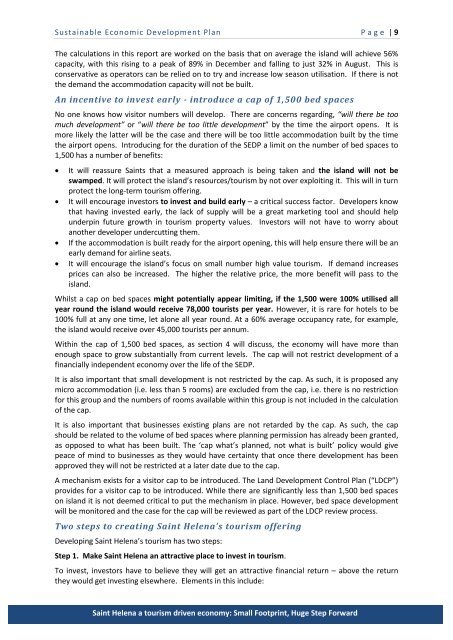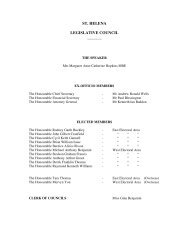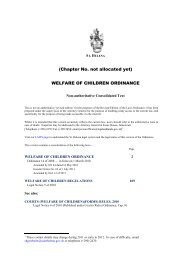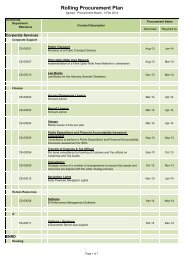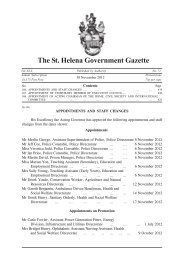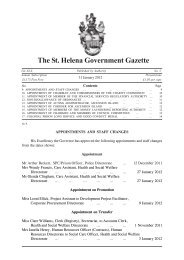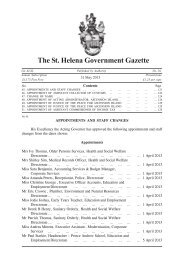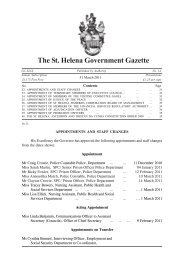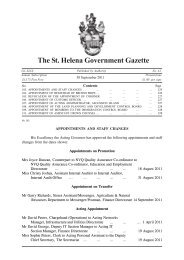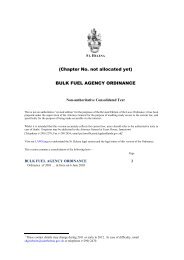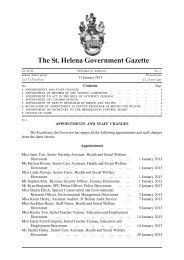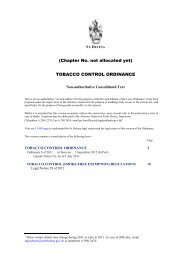Sustainable Economic Development Plan 2012/13 - St Helena
Sustainable Economic Development Plan 2012/13 - St Helena
Sustainable Economic Development Plan 2012/13 - St Helena
Create successful ePaper yourself
Turn your PDF publications into a flip-book with our unique Google optimized e-Paper software.
<strong>Sustainable</strong> <strong>Economic</strong> <strong>Development</strong> <strong>Plan</strong> P a g e | 9<br />
The calculations in this report are worked on the basis that on average the island will achieve 56%<br />
capacity, with this rising to a peak of 89% in December and falling to just 32% in August. This is<br />
conservative as operators can be relied on to try and increase low season utilisation. If there is not<br />
the demand the accommodation capacity will not be built.<br />
An incentive to invest early - introduce a cap of 1,500 bed spaces<br />
No one knows how visitor numbers will develop. There are concerns regarding, “will there be too<br />
much development” or “will there be too little development” by the time the airport opens. It is<br />
more likely the latter will be the case and there will be too little accommodation built by the time<br />
the airport opens. Introducing for the duration of the SEDP a limit on the number of bed spaces to<br />
1,500 has a number of benefits:<br />
<br />
<br />
<br />
<br />
It will reassure Saints that a measured approach is being taken and the island will not be<br />
swamped. It will protect the island’s resources/tourism by not over exploiting it. This will in turn<br />
protect the long-term tourism offering.<br />
It will encourage investors to invest and build early – a critical success factor. Developers know<br />
that having invested early, the lack of supply will be a great marketing tool and should help<br />
underpin future growth in tourism property values. Investors will not have to worry about<br />
another developer undercutting them.<br />
If the accommodation is built ready for the airport opening, this will help ensure there will be an<br />
early demand for airline seats.<br />
It will encourage the island’s focus on small number high value tourism. If demand increases<br />
prices can also be increased. The higher the relative price, the more benefit will pass to the<br />
island.<br />
Whilst a cap on bed spaces might potentially appear limiting, if the 1,500 were 100% utilised all<br />
year round the island would receive 78,000 tourists per year. However, it is rare for hotels to be<br />
100% full at any one time, let alone all year round. At a 60% average occupancy rate, for example,<br />
the island would receive over 45,000 tourists per annum.<br />
Within the cap of 1,500 bed spaces, as section 4 will discuss, the economy will have more than<br />
enough space to grow substantially from current levels. The cap will not restrict development of a<br />
financially independent economy over the life of the SEDP.<br />
It is also important that small development is not restricted by the cap. As such, it is proposed any<br />
micro accommodation (i.e. less than 5 rooms) are excluded from the cap, i.e. there is no restriction<br />
for this group and the numbers of rooms available within this group is not included in the calculation<br />
of the cap.<br />
It is also important that businesses existing plans are not retarded by the cap. As such, the cap<br />
should be related to the volume of bed spaces where planning permission has already been granted,<br />
as opposed to what has been built. The ‘cap what’s planned, not what is built’ policy would give<br />
peace of mind to businesses as they would have certainty that once there development has been<br />
approved they will not be restricted at a later date due to the cap.<br />
A mechanism exists for a visitor cap to be introduced. The Land <strong>Development</strong> Control <strong>Plan</strong> (“LDCP”)<br />
provides for a visitor cap to be introduced. While there are significantly less than 1,500 bed spaces<br />
on island it is not deemed critical to put the mechanism in place. However, bed space development<br />
will be monitored and the case for the cap will be reviewed as part of the LDCP review process.<br />
Two steps to creating Saint <strong>Helena</strong>’s tourism offering<br />
Developing Saint <strong>Helena</strong>’s tourism has two steps:<br />
<strong>St</strong>ep 1. Make Saint <strong>Helena</strong> an attractive place to invest in tourism.<br />
To invest, investors have to believe they will get an attractive financial return – above the return<br />
they would get investing elsewhere. Elements in this include:<br />
Saint <strong>Helena</strong> a tourism driven economy: Small Footprint, Huge <strong>St</strong>ep Forward


